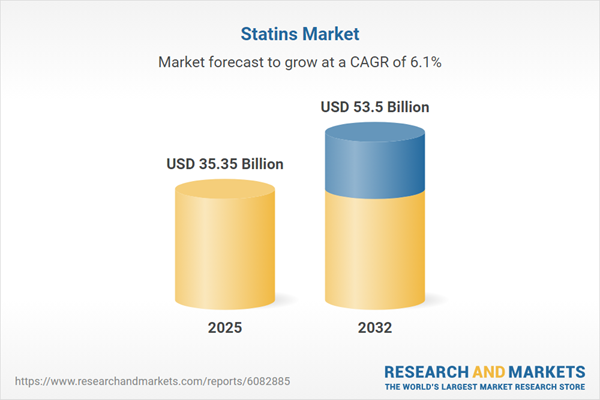Speak directly to the analyst to clarify any post sales queries you may have.
The statins market is undergoing robust change as advancements in cardiovascular care, regulatory updates, and emerging clinical practices redefine industry dynamics. Senior decision-makers need timely, actionable insights to navigate shifting trends and shape resilient, growth-oriented strategies amid competitive pressures.
Statins Market Snapshot
Global demand for statins continues to rise as the prevalence of cardiovascular disorders grows worldwide. Evolution in lipid-lowering therapy adoption, along with new clinical guidelines and expanded preventive initiatives, is increasing usage across both developed and emerging economies. Innovation in product formulations, including both branded and generic options, contributes to a dynamic competitive landscape. Key regulatory changes, the introduction of combination therapies, and manufacturing improvements are further driving market fluidity. Entry of biosimilars and shifting tariff structures are reshaping competitive conditions, challenging both established and new entrants to adapt their market approaches.
Scope & Segmentation
- Product Types: Branded statins such as atorvastatin, rosuvastatin, and simvastatin are featured alongside a complete range of generic statin products. These products enable customized patient management strategies in various clinical settings.
- Dosage Forms: Capsules and tablets are available in immediate and modified-release formulations, enhancing dosing precision and patient adherence, especially in chronic disease management programs.
- Distribution Channels: Hospital pharmacies provide for acute intervention needs, while retail pharmacies and online channels have increased reach and improved support for ongoing therapy and remotely managed care.
- End Users: Clinics, hospitals, specialty centers, and homecare facilities comprise the main end-user groups, each requiring tailored education, logistical support, and targeted supply chains.
- Geographies: Major regions include the Americas—United States, Canada, Mexico, and leading Latin American countries—Europe, Middle East, Africa, and Asia-Pacific markets such as China, India, Japan, and Australia. Rapidly growing regions are expanding access and shaping new demand clusters.
- Corporate Coverage: Leading manufacturers in the statins market include Pfizer Inc., AstraZeneca PLC, Merck & Co., Novartis AG, Teva Pharmaceutical Industries, Sandoz International, Viatris Inc., Sun Pharmaceuticals, Dr. Reddy's Laboratories, and Apotex Inc.
Key Takeaways
- Statins consistently serve as the preferred option for lipid management in diverse patient populations, with updated clinical practices helping to sustain broad-based adoption.
- Advancements in technology, particularly digital health platforms and predictive analytics, are improving monitoring and individualized therapy protocols, facilitating stronger patient adherence and engagement.
- The growing availability of generic and biosimilar statins is increasing access and creating fiercer competition, particularly in cost-sensitive markets and regions seeking affordable care solutions.
- Regional variations in policy, reimbursement frameworks, and distribution structures are driving the need for adaptable market entry strategies and agile resource deployment from both manufacturers and distributors.
- Strategic partnerships with digital health innovators, research bodies, and local distribution networks support rapid adaptation to evolving trends, as well as improved supply-chain flexibility.
- Ongoing research and development in statin combinations, biomarker-driven approaches, and advanced delivery techniques are contributing to market differentiation and long-term platform stability.
Tariff Impact: Navigating New U.S. Policies
Forthcoming tariff regulations in the United States, planned for 2025, are impacting manufacturers and the broader statins market supply chain. Increased duties on pharmaceutical ingredients are encouraging companies to reassess sourcing and inventory management. This is resulting in operational changes to logistics and warehouse practices, with a focus on cost optimization and supply continuity. Many major manufacturers have initiated the localization of production, strategic realignment of critical operations, and the formation of partnerships in regions exempt from new duties to maintain steady market access as policy shifts continue.
Methodology & Data Sources
This analysis is grounded in comprehensive secondary research including peer-reviewed studies, regulatory documents, and proprietary pharmaceutical databases. Insights were validated through interviews with senior stakeholders, clinicians, and supply-chain experts to enhance reliability and support well-founded market decisions.
Why This Report Matters
- Offers a consolidated overview of the statins market, enabling strategic investment planning and portfolio optimization across all major geographies and segments.
- Equips leadership teams to anticipate and proactively respond to changes in tariff regimes, regulatory conditions, and competitor strategies, strengthening risk management and opportunity capture.
- Delivers actionable insights for improving policy alignment, research and development, and market-access tactics in line with evolving cardiovascular therapy standards.
Conclusion
The statins market is adapting quickly to ongoing innovation, regulatory pressures, and geographic variation. Executives leveraging technology, following emerging therapy trends, and deploying resilient supply strategies will strengthen growth prospects and maintain long-term market relevance.
Table of Contents
3. Executive Summary
4. Market Overview
7. Cumulative Impact of Artificial Intelligence 2025
Companies Mentioned
The companies profiled in this Statins market report include:- Pfizer Inc.
- AstraZeneca PLC
- Merck & Co., Inc.
- Novartis AG
- Teva Pharmaceutical Industries Ltd.
- Sandoz International GmbH
- Viatris Inc.
- Sun Pharmaceutical Industries Ltd.
- Dr. Reddy's Laboratories Limited
- Apotex Inc.
Table Information
| Report Attribute | Details |
|---|---|
| No. of Pages | 184 |
| Published | October 2025 |
| Forecast Period | 2025 - 2032 |
| Estimated Market Value ( USD | $ 35.35 Billion |
| Forecasted Market Value ( USD | $ 53.5 Billion |
| Compound Annual Growth Rate | 6.1% |
| Regions Covered | Global |
| No. of Companies Mentioned | 11 |









